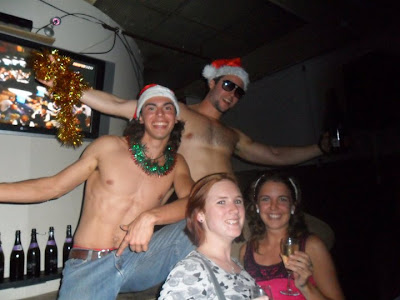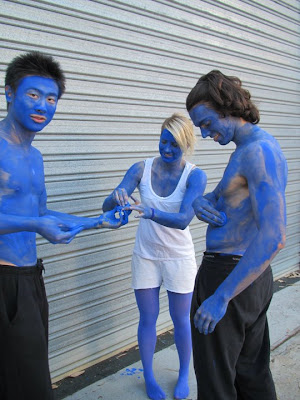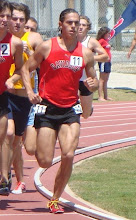The past six months have certainly been life-changing and although the experience is far from over, I’ve taken some time the past two weeks to reflect on the past 6 months of traveling and parkour has given me.
Well, for one thing, I’ve gotten very comfortable living in hostels and become pretty adept at getting comfortable to a new cities and surroundings. My general state of independence has been very liberating for me after having my schedule pretty packed for the past 6 or 7 years back home. I hadn’t realized how much things are dictated by the norm back home; do well in school, sports, and extracurriculars so that colleges want you; then once you're there, do really well in school, sports, and extracurriculars so that employers want you. Sleep and eat when possible. I'll admit, escaping from all that was a bit of a shock to the system at first (what does "free time" mean?), but I'm really enjoying it now.
It really wasn’t until my recent stay in Sydney with my family that I realized just how independent I had become. Since one of the few rules that Watson Fellows must follow is to travel solo for their entire journey (no travel-buddies, limited visits from friends and family) I’ve spent a lot of time with myself. I’ve come to realize that as much as I value this independence and total freedom to do what I want and follow my passion (albeit within the constraints of my budget), I really miss having someone to share things with. I’ve found that the moments that I’ve enjoyed the most on my trip so far have all involved the people that I meet and the experiences that I have with them. While I’m definitely looking forward to the second half of this adventure, I’m also looking forward to the point at which I can choose to continue my travels with friends from home or ones that I make on the way.
So how about the progress on the parkour front? One of the problems about working with traceurs from all over the world is that realize how many amazing traceurs there are out there. While this has been great, it also means that I’m very hesitant to put any of my own stuff out there because I know that it doesn’t measure up. I know that parkour is “non-competitive”, but there is part of me that doesn’t want to put stuff out there until I feel like it can measure up to at least a decent standard.
That being said, my movement has definitely made a lot of progress. Actually, that is probably an understatement- my movement doesn’t even resemble what it did before. When I first got to London I had trouble balancing on railings, sticking landings, couldn’t do a muscle up, and felt generally stiff and awkward in my movements. Today, I will be the first to admit that I have a lot to do before I can deem myself “competent” in parkour, but I can now do the basic vaults and I’m familiar with all the movements. I’ve also managed to establish a base-line of conditioning that I hope to steadily improve on, adding exercises and techniques that I encounter along the way.
 |
| The world is now my playground... |
While a lot of people (including myself) expressed doubts about my personal safety when I mentioned that I would be going around the world for a year doing and studying parkour, I’ve found that apart from a number of cuts and scrapes that heal within a week or so, I’ve managed to avoid any major injuries (knock on wood). I think that is partly due to the fact that I’m not doing any huge or ridiculous jumps that are outside of my ability level, and partly due to the intense conditioning that I’ve been doing. While major injuries were a concern, I was also worried that the quick changeover from track/athletics to parkour would be too much for certain underused muscle groups and lead to repetitive-stress injuries. I have to give a lot of credit to the intense conditioning sessions in London for the fact that for the most part, I’ve been able to avoid any of these injuries (keep knocking on that wood). I also suspect that the lack of stress fractures or tendonitis has a strong relationship to the fact that I get a lot more sleep than at Davidson now that I don’t have loads of schoolwork and extracurricular activities.
The first 6 months of my research on parkour, interestingly enough; has been limited to two very developed English-speaking countries. While both organizations that I worked with had different approaches to their instruction of parkour, in general the “essence”, or philosophy, of the sport was pretty similar in both places. I suspect that the fact that both countries had regular classes, instructors, and training spots already sets them out ahead of some of the other countries that I’ll be visiting. Both countries also seem to have established a distinction between parkour and freerunning, although the manner in which they deal with that division differs.
One of the things that I’m also looking forward to is being in an environment where English is not the primary language. During previous travels I’ve learned that one of the best ways for me to adapt to a new country is to immerse myself in the native language. While it can be argued that British or Aussie English is not the same as “Yankee” English, these three countries have a lot more in common than just their language and I’m looking forward to the challenge of living in other cultures that have different ideas. I’ll have plenty of opportunity for that soon as the next half of the trip will include 6 countries, 5 different languages (of which I know 2), and a wide spectrum of different interpretations of parkour.
Perhaps the most important thing that I’ve gotten from the past 6 months is a network of friends that spans the globe. Since London and Paris are sort of “Meccas” for the sport, my time in those places allowed me to make contact with a number of people from around the world and has also allowed me to brush shoulders with some of the “greats” of the sport. In addition to that, my time in these cities (and Melbourne) has also allowed me to become friends with a number of traceurs that are visiting or living there. As I mentioned before, most of the best moments of the trip so far have been those that I’ve shared with my new friends, and a lot of these moments have occurred while training (or after training). There is something (beside the endorphins) about sweating and bleeding together that brings people closer together a lot faster than normal. As one person in Melbourne put it, “Parkour training includes a level of intensity that lays a person’s fears and weaknesses bare, but more importantly, it shows you how they deal with them. This cuts out the awkward 6-12 month period that it takes to really get to know someone just by hanging out with them.”
 |
| Parkour love in France... |
 |
| in London... |
 |
| and in Melbourne. |
So what am I looking forward to the most in the second half of the trip? Well, the chance to brush up on my Spanish again will be nice, and I’m really looking forward to learning some Portuguese and Italian. I’m also excited to see what countries like Argentina, Chile, and Brazil bring to parkour in terms of “Latin flavor”. And of course, all the great things that I've heard about training in Denmark and Italy are pretty appealing. Most of all, I think that I’m looking forward to the fact that I have no idea what things will be like in the next countries that I visit, and no idea what changes to my itinerary will occur. Maybe I’m just feeling restless and curious, but I’m ready to wander…
 |
| By the Harbor Bridge in Sydney |





















.jpg)


